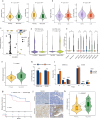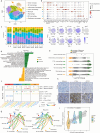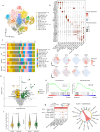Single-cell analysis reveals a longitudinal trajectory of meningioma evolution and heterogeneity
- PMID: 40593590
- PMCID: PMC12217859
- DOI: 10.1038/s41467-025-60653-0
Single-cell analysis reveals a longitudinal trajectory of meningioma evolution and heterogeneity
Abstract
Meningioma is the most prevalent primary brain tumor with extensive intra-tumoral heterogeneity and high recurrence rates, particularly in high-grade meningiomas. Despite advancements in understanding the molecular underpinnings of meningiomas, the longitudinal evolutionary trajectory and cellular diversity of recurrent tumors remain elusive. In this study, we perform single-nuclei sequencing of matched primary and recurrent meningiomas to explore the dynamic transcriptional heterogeneity and evolutionary trajectory of meningioma tumor cells, as well as their molecular interactions with tumor-associated immune cells that shape the complex milieu of the meningioma microenvironment. Our findings reveal that both primary and recurrent meningiomas constitute diverse cellular compositions and hierarchies, where recurrent tumor cells are characterized by enrichments of cell cycle activities and proliferative kinetics. Integrative RNA velocity and latent time uncover divergent transcriptional trajectories in recurrent tumors, demonstrating multidirectional transitions with the dominance of COL6A3, which confers higher risk vulnerability and treatment resistance. Tumor microenvironment analysis further reveals enrichments of COL6A3-mediated interactions between immunosuppressive macrophages and tumor cells in recurrent meningiomas. Collectively, these results provide profound insights into the complex evolutionary process of meningiomas and suggest potential therapeutic strategies for the treatment of recurrent tumors.
© 2025. The Author(s).
Conflict of interest statement
Competing interests: The authors declare no competing interests. Ethics approval and consent to participate: The research conformed to the principles of the Declaration of Helsinki.
Figures





References
MeSH terms
Grants and funding
LinkOut - more resources
Full Text Sources
Miscellaneous

